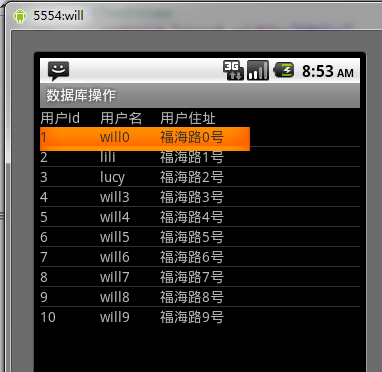жӮЁеҘҪпјҢзҷ»еҪ•еҗҺжүҚиғҪдёӢи®ўеҚ•е“ҰпјҒ
е°Ҹзј–з»ҷеӨ§е®¶еҲҶдә«дёҖдёӢAndroidдёӯеҰӮдҪ•е®һзҺ°SQLiteдәӢеҠЎеӨ„зҗҶз»“еҗҲListviewеҲ—иЎЁжҳҫзӨәеҠҹиғҪпјҢзӣёдҝЎеӨ§йғЁеҲҶдәәйғҪиҝҳдёҚжҖҺд№ҲдәҶи§ЈпјҢеӣ жӯӨеҲҶдә«иҝҷзҜҮж–Үз« з»ҷеӨ§е®¶еҸӮиҖғдёҖдёӢпјҢеёҢжңӣеӨ§е®¶йҳ…иҜ»е®ҢиҝҷзҜҮж–Үз« еҗҺеӨ§жңү收иҺ·пјҢдёӢйқўи®©жҲ‘们дёҖиө·еҺ»дәҶи§ЈдёҖдёӢеҗ§пјҒ
е…·дҪ“еҰӮдёӢпјҡ
еүҚйқўзҡ„ж–Үз« йҮҢд»Ӣз»ҚиҝҮдәӢеҠЎзҡ„зү№зӮ№еҰӮеҺҹеӯҗжҖ§пјҢйҡ”зҰ»жҖ§пјҢдёҖиҮҙжҖ§пјҢжҢҒд№…жҖ§гҖӮдёӢйқўе°ұз»“еҗҲAndroidзҡ„sqliteжқҘиҜҙдёӢпјҢиҝҷж¬Ўзҡ„ж–Үз« йҮҢдјҡжҠҠlistviewд№ҹз»“еҗҲиө·жқҘз”ЁгҖӮе®һйҷ…дёҠandroidйҮҢзҡ„дәӢеҠЎе’ҢжҲ‘们数жҚ®еә“йҮҢзҡ„жҳҜдёҖж ·зҡ„гҖӮд№ҹжҳҜејҖеҗҜдәӢеҠЎпјҢж“ҚдҪңпјҢжҸҗдәӨдәӢеҠЎгҖӮеҰӮжһңеҮәзҺ°й—®йўҳе°ұеӣһж»ҡгҖӮ
public void Transaction(){
SQLiteDatabase database=db.getReadableDatabase();
database.beginTransaction(); //ејҖеҗҜдәӢеҠЎ
try{
String sql1="update student set username='lili' where userid=2";
String sql2="update student set username='lucy' where userid=3";
database.execSQL(sql1);
database.execSQL(sql2);
database.setTransactionSuccessful(); //и®ҫзҪ®дәӢеҠЎзҡ„зҠ¶жҖҒпјҢиҝҷеҸҘдёҚеҶҷдәӢеҠЎе°ұдјҡеӣһж»ҡ
}finally{
database.endTransaction(); //з»“жқҹдәӢеҠЎ
}
}дёҠйқўиҝҷж®өд»Јз Ғе°ұжҳҜдёҖдёӘз®ҖеҚ•зҡ„дәӢеҠЎж“ҚдҪңпјҢйңҖиҰҒжіЁж„Ҹзҡ„е°ұжҳҜиҰҒжҚ•иҺ·ејӮеёёпјҢиҝҷж ·дәӢеҠЎе°ұдјҡиў«з»“жқҹжҺүеҸҜд»ҘиҠӮзәҰж•°жҚ®еә“иө„жәҗгҖӮ
дәӢеҠЎзҡ„ж“ҚдҪңе°ұжҳҜиҝҷж ·пјҢдёӢйқўе°ұд»Ӣз»ҚдёӢlistviewзҡ„дҪҝз”ЁпјҢжҲ‘们зҗҶи§ЈжҲҗеҲ—иЎЁе°ұеҸҜд»ҘдәҶгҖӮз•ҢйқўеҰӮдёӢ

жҲ‘们еҸҜд»ҘжҠҠиҝҷдёӘз•ҢйқўжӢҶжҲҗ2дёӘпјҢдё»з•Ңйқўе°ұеҸӘжңүвҖңз”ЁжҲ·idвҖқпјҢвҖңз”ЁжҲ·еҗҚвҖқпјҢвҖңз”ЁжҲ·дҪҸеқҖвҖқд№ҹе°ұжҳҜеҲ—иЎЁзҡ„еӨҙпјҢдё»з•ҢйқўеҰӮдёӢ
<?xml version="1.0" encoding="utf-8"?> <LinearLayout xmlns:android="http://schemas.android.com/apk/res/android" android:orientation="vertical" android:layout_width="fill_parent" android:layout_height="fill_parent" > <LinearLayout xmlns:android="http://schemas.android.com/apk/res/android" android:orientation="horizontal" android:layout_width="wrap_content" android:layout_height="wrap_content"> <TextView android:layout_width="60dip" android:layout_height="wrap_content" android:text="з”ЁжҲ·id" /> <TextView android:layout_width="60dip" android:layout_height="wrap_content" android:text="з”ЁжҲ·еҗҚ" /> <TextView android:layout_width="60dip" android:layout_height="wrap_content" android:text="з”ЁжҲ·дҪҸеқҖ" /> </LinearLayout> <ListView android:layout_width="fill_parent" android:layout_height="wrap_content" android:id="@+id/listview" /> </LinearLayout>
иҝҷйҮҢзҡ„listviewиҰҒе®ҡд№үдёҖдёӘidжҸҗдҫӣеҗҺйқўж•°жҚ®з»‘е®ҡдҪҝз”ЁпјҢеҗ«жңүеҶ…е®№зҡ„жҳҫзӨәз•Ңйқўд№ҹжҜ”иҫғз®ҖеҚ•пјҢд№ҹе°ұжҳҜеҮ дёӘtextview
<?xml version="1.0" encoding="utf-8"?> <LinearLayout xmlns:android="http://schemas.android.com/apk/res/android" android:orientation="horizontal" android:layout_width="wrap_content" android:layout_height="wrap_content"> <TextView android:layout_width="60dip" android:layout_height="wrap_content" android:id="@+id/userid" /> <TextView android:layout_width="60dip" android:layout_height="wrap_content" android:id="@+id/username" /> <TextView android:layout_width="90dip" android:layout_height="wrap_content" android:id="@+id/address" /> </LinearLayout>
иҝҷж ·з•Ңйқўзҡ„йғЁеҲҶе°ұOKдәҶпјҢжҺҘдёӢжқҘе°ұжҳҜиҜ»еҸ–ж•°жҚ®дәҶпјҢд№ӢеҗҺжҳҫзӨәеңЁlistviewдёӯпјҢеңЁиҝҷйҮҢе°ұжҸҗдҫӣ2з§Қж–№жі•жқҘжҳҫзӨәж•°жҚ®
пјҲ1пјүж–№жі•1
package org.lxh.db;
import java.util.*;
import org.lxh.service.StudentService;
import org.lxh.vo.Student;
import android.app.Activity;
import android.database.Cursor;
import android.os.Bundle;
import android.view.View;
import android.widget.AdapterView;
import android.widget.AdapterView.OnItemClickListener;
import android.widget.ListView;
import android.widget.SimpleAdapter;
import android.widget.SimpleCursorAdapter;
import android.widget.Toast;
public class DBActivity extends Activity {
private StudentService service;
public void onCreate(Bundle savedInstanceState) {
super.onCreate(savedInstanceState);
setContentView(R.layout.main);
this.service=new StudentService(this);
ListView view=(ListView)this.findViewById(R.id.listview);
List<Student> all=this.service.fiandAll();
List<HashMap<String,Object>> data=new ArrayList<HashMap<String,Object>>();
//йҖҗдёӘеҸ–еҮәе…ғзҙ
Iterator<Student> it=all.iterator();
Student stu=null;
while(it.hasNext()){
stu=new Student();
stu=it.next();
HashMap<String,Object> map=new HashMap<String,Object>();
map.put("userid", stu.getUserid());
map.put("username", stu.getUsername());
map.put("address", stu.getAddress());
data.add(map);
}
//ж•°жҚ®з»‘е®ҡ
SimpleAdapter adapter=new SimpleAdapter(this, data, R.layout.listview, new String[]{"userid","username","address"},new int[]{R.id.userid,R.id.username,R.id.address});
view.setAdapter(adapter);
//ж·»еҠ еҲ—иЎЁйЎ№зӣ‘еҗ¬дәӢ件
view.setOnItemClickListener(new OnItemClickListener(){
public void onItemClick(AdapterView<?> parent, View view,int position, long id) {
ListView listview=(ListView)parent;
HashMap<String,Object> hash=(HashMap<String,Object>)listview.getItemAtPosition(position);
Toast.makeText(DBActivity.this, hash.get("userid").toString(), 1).show();
}});
}иҝҷйҮҢзҡ„ж•°жҚ®з»‘е®ҡпјҢдҪҝз”Ёзҡ„жҳҜSimpleAdapterпјҢжҲ‘们йҰ–е…ҲиҰҒеҒҡзҡ„е°ұжҳҜжҠҠж•°жҚ®йҖҗдёӘеҸ–еҮәжқҘеӯҳе…ҘдёҖдёӘHashMap,еҰӮдёӢжүҖзӨә
HashMap<String,Object> map=new HashMap<String,Object>();
иҝҷйҮҢзҡ„hashmapеӯҳеӮЁзҡ„жҳҜжіӣеһӢж•°жҚ®пјҢиҝҷдёӘйӣҶеҗҲзҡ„жіӣеһӢдёҚиғҪйҡҸдҫҝдҝ®ж”№пјҢжҺҘдёӢжқҘзҡ„е·ҘдҪңе°ұжҳҜжҠҠиҝҷдёӘйӣҶеҗҲеҪ“еҒҡlistзҡ„жіӣеһӢ
List<HashMap<String,Object>> data=new ArrayList<HashMap<String,Object>>();
жңҖеҗҺиҰҒи®°еҫ—жҠҠиҝҷдёӘmapж·»еҠ еҲ°йӣҶеҗҲйҮҢ
еҜ№дәҺ
SimpleAdapter adapter=new SimpleAdapter(this, data, R.layout.listview, new String[]{"userid","username","address"},new int[]{R.id.userid,R.id.username,R.id.address});
view.setAdapter(adapter);第еӣӣдёӘеҸӮж•°йҮҢзҡ„"userid","username","address"жҳҜmapйӣҶеҗҲйҮҢзҡ„keyпјҢжңҖеҗҺдёҖдёӘеҸӮж•°жҳҜtextview,д№ҹе°ұжҳҜж•°жҚ®з•ҢйқўйҮҢзҡ„textview.еҗҺйқўиҝҳеҠ дәҶдёӘзӣ‘еҗ¬пјҢеҸӘиҰҒзӮ№еҮ»textviewе°ұдјҡжҳҫзӨәз”ЁжҲ·idпјҢandroidе°ұдјҡйҖҡиҝҮtextviewзҡ„дҪҚзҪ®иҜ»еҸ–еҶ…е®№гҖӮ
иҝҷйҮҢжҠҠе…ҲиҜ»ж•°жҚ®зҡ„д»Јз Ғе…ҲиҙҙеҮәжқҘ
public List<Student> fiandAll(){
List<Student> all=new ArrayList<Student>();
String sql="select * from student";
SQLiteDatabase database=db.getReadableDatabase(); //дҪҝз”ЁgetReadableDatabaseеҸ–еҫ—SQLiteDatabase
Cursor cursor=database.rawQuery(sql, null); //еҫ—еҲ°жёёж Ү,зұ»дјјresultset
Student stu;
while(cursor.moveToNext()){ //移еҠЁжёёж Ү
int id=cursor.getInt(cursor.getColumnIndex("userid"));
String name=cursor.getString(cursor.getColumnIndex("username"));
String address=cursor.getString(cursor.getColumnIndex("address"));
stu=new Student();
stu.setUserid(id);
stu.setUsername(name);
stu.setAddress(address);
all.add(stu);
}
cursor.close(); //е…ій—ӯжёёж Ү
return all;
}пјҲ2пјүжёёж ҮйҖӮй…ҚеҷЁ
дёӢйқўжҳҜиҜ»ж•°жҚ®зҡ„д»Јз Ғ
public Cursor fiandAllCursor(){
List<Student> all=new ArrayList<Student>();
String sql="select userid as _id,username,address from student";
SQLiteDatabase database=db.getReadableDatabase(); //дҪҝз”ЁgetReadableDatabaseеҸ–еҫ—SQLiteDatabase
Cursor cursor=database.rawQuery(sql, null); //еҫ—еҲ°жёёж Ү,зұ»дјјresultset
//cursor.close(); //иҝҷйҮҢдёҚеҸҜд»Ҙе…ій—ӯжёёж Ү
return cursor;
}иҝҷйҮҢдёәдё»й”®зҡ„еҲ—еҸ–дәҶеҲ«еҗҚжҳҜеӣ дёәandroidеҶ…йғЁе»әи®®дё»й”®и®ҫзҪ®дёә_id,дҪҶжҳҜдёҚеҸҜиғҪжҜҸдёӘиЎЁзҡ„дё»й”®зҡ„еҗҚз§°йғҪжҳҜ_id
Cursor all=this.service.fiandAllCursor(); //дҪҝз”Ёжёёж ҮйҖӮй…ҚеҷЁ
SimpleCursorAdapter cadapter=new SimpleCursorAdapter(this, R.layout.listview,all, new String[]{"_id","username","address"},new int[]{R.id.userid,R.id.username,R.id.address});
view.setAdapter(cadapter);
//ж·»еҠ еҲ—иЎЁйЎ№зӣ‘еҗ¬дәӢ件
view.setOnItemClickListener(new OnItemClickListener(){
public void onItemClick(AdapterView<?> parent, View view,int position, long id) {
ListView listview=(ListView)parent;
Cursor hash=(Cursor)listview.getItemAtPosition(position); //еҸ–еҫ—иў«зӮ№еҮ»itemзҡ„дҪҚзҪ®
int temp=hash.getInt(hash.getColumnIndex("_id"));
Toast.makeText(DBActivity.this, String.valueOf(temp), 1).show();
}});иҝҷйҮҢзҡ„йҖӮй…ҚеҷЁеҸӮж•°йЎәеәҸе’ҢдёҠйқўзҡ„жңүзӮ№дёҚеҗҢпјҢиҖҢ且第еӣӣдёӘеҸӮж•°йҮҢзҡ„вҖңusernamвҖқ,"address"е’Ң'_id'йғҪжҳҜиЎЁзҡ„еҲ—еҗҚгҖӮе…¶д»–ең°ж–№жІЎеӨӘеӨ§еҢәеҲ«пјҢдёҠйқўзҡ„вҖң_idвҖқд№ҹдёҚиғҪеҶҷжҲҗеҲ«зҡ„гҖӮеҗҰеҲҷдјҡеҮәй”ҷ
д»ҘдёҠжҳҜвҖңAndroidдёӯеҰӮдҪ•е®һзҺ°SQLiteдәӢеҠЎеӨ„зҗҶз»“еҗҲListviewеҲ—иЎЁжҳҫзӨәеҠҹиғҪвҖқиҝҷзҜҮж–Үз« зҡ„жүҖжңүеҶ…е®№пјҢж„ҹи°ўеҗ„дҪҚзҡ„йҳ…иҜ»пјҒзӣёдҝЎеӨ§е®¶йғҪжңүдәҶдёҖе®ҡзҡ„дәҶи§ЈпјҢеёҢжңӣеҲҶдә«зҡ„еҶ…е®№еҜ№еӨ§е®¶жңүжүҖеё®еҠ©пјҢеҰӮжһңиҝҳжғіеӯҰд№ жӣҙеӨҡзҹҘиҜҶпјҢж¬ўиҝҺе…іжіЁдәҝйҖҹдә‘иЎҢдёҡиө„и®Ҝйў‘йҒ“пјҒ
е…ҚиҙЈеЈ°жҳҺпјҡжң¬з«ҷеҸ‘еёғзҡ„еҶ…е®№пјҲеӣҫзүҮгҖҒи§Ҷйў‘е’Ңж–Үеӯ—пјүд»ҘеҺҹеҲӣгҖҒиҪ¬иҪҪе’ҢеҲҶдә«дёәдё»пјҢж–Үз« и§ӮзӮ№дёҚд»ЈиЎЁжң¬зҪ‘з«ҷз«ӢеңәпјҢеҰӮжһңж¶үеҸҠдҫөжқғиҜ·иҒ”зі»з«ҷй•ҝйӮ®з®ұпјҡis@yisu.comиҝӣиЎҢдёҫжҠҘпјҢ并жҸҗдҫӣзӣёе…іиҜҒжҚ®пјҢдёҖз»ҸжҹҘе®һпјҢе°Ҷз«ӢеҲ»еҲ йҷӨж¶үе«ҢдҫөжқғеҶ…е®№гҖӮ
жӮЁеҘҪпјҢзҷ»еҪ•еҗҺжүҚиғҪдёӢи®ўеҚ•е“ҰпјҒ